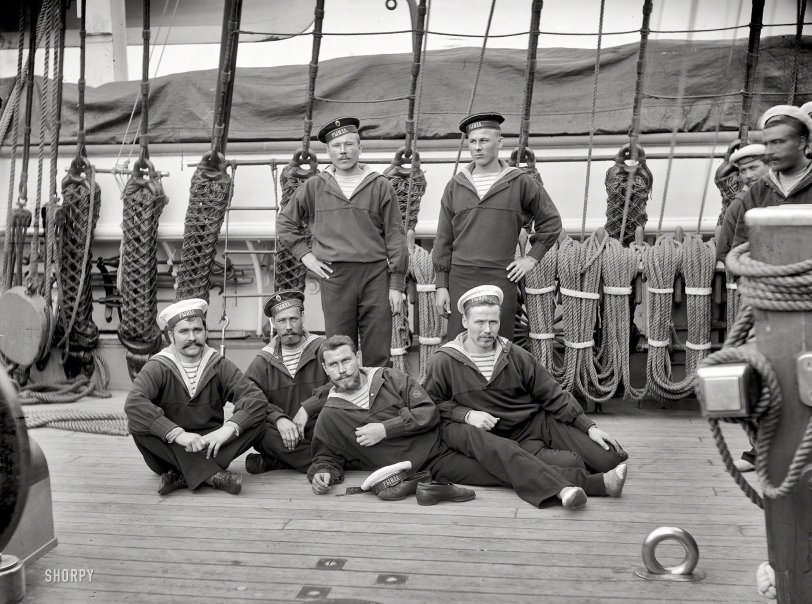


Framed or unframed, desk size to sofa size, printed by us in Arizona and Alabama since 2007. Explore now.
Shorpy is funded by you. Patreon contributors get an ad-free experience.
Learn more.

- Baldwin 62303
- Baldwin VO-1000
- Cold
- No expense spared
- Tough Guys
- Lost in Toyland
- And without gloves
- If I were a blindfolded time traveler
- Smoke Consumer Also Cooks
- Oh that stove!
- Possibly still there?
- What?!?
- $100 Reward
- Freeze Frame
- Texas Flyer wanted
- Just a Year Too Soon
- WWII -- Replacing men with women at the railroad crossing.
- Yes, Icing
- You kids drive me nuts!
- NOT An Easy Job
- I wonder
- Just add window boxes
- Icing Platform?
- Indiana Harbor Belt abides
- Freezing haze
- Corrections (for those who care)
- C&NW at Nelson
- Fallen Flags
- A dangerous job made worse
- Water Stop
Print Emporium
Russian Navy: 1893

New York, 1893. "Columbian Naval Review. Group of sailors, Imperial Russian Navy." 8x10 inch glass negative, Detroit Publishing Company. View full size.
Rynda [Bell] Sailors
Look at Imperial Navy: 1893 for РЫНДА ship & crew.
Not "ship's bell"
In Russian Imperial Navy corvettes and cruisers were named for military people:
Warrior, Boyar, Novik, Posadnik, Voevoda, Rynda, Griden, etc.
The Russians Are Coming, the Russians Are Coming!
"Emergency. Everybody to get from street."
Newspaper article
dated February 13, 1888 that describes a visit by Rynda to Melbourne, Australia. Includes a detailed description of the ship:
Old Navy
It looks like there was no footwear protocol.
Rynda
Capn_Jack has most of the letters correct.
The 'b|' that looks like two characters is just one.
I'm told that it's pronounced something like the tail of the French "Oui", with a "rounded" tongue. After 14 years, my adopted Russian daughter still laughs at me when I attempt it!
Inscription on Sailors' Hats
I believe the hats say рында meaning "bell" or more specifically "ship's bell".
Out of place?
Man on the right, second row - seems to be the only one without facial fungus.
Cruiser Rynda
According to "The International Columbian Naval Rendezvous and Review of April, 1893," by LT. George Peters USN (available from Google Books), the cruiser Rynda was the second foreign ship to arrive, on April 10, 1893. That the photo was taken on board her (although other Russian ships attended) is shown by the lettering on the men's hats, which even to someone only slightly familiar with the Cirillic letters evidently spells out something like that -- not sure where the "y" sound comes from but the P-like letter is definitely a Cyrillic "R" and the "H"-like letter would have the "N" sound.
There is lots to admire in the photo. The bow is to the right because of the angles of shrouds and backstays. The rigging is an odd mixture of modern and ancient practices, with iron or steel wire shrouds with eyes crimped in them using a process not much different from today's swaging, but tensioned by deadeyes and lanyards that would be instantly recognizeable to someone who had sailed with Drake or Anson. The mesh covering the lanyards is decorative and would have had to be removed to tension them. The crew must have spent countless hours polishing that padeye in the foreground. The coiled running rigging on the pinrail is made hyper-neat for inspection by the ropework loops holding it in place, but of course they would have to be removed to handle the sails.
There is a Wikipedia article (not much of one, but it does have a photo) of this class of ship (built 1883). It shows a barque rigged steamship with 2 funnels between fore and main masts. Two ships were built, and Rynda herself survived to be renamed Osvoboditel' after the Revolution, in 5/8/1917. The word "Rynda" means an unpaid, Imperial bodyguard of noblemen that was abolished by Peter the Great. The Imperial Navy had several ships by that name over the years, which is rather odd since the Russian Navy was pretty much created by the same tsar who had abolished the Rynda.
Apparently it survived
Just over a decade after this photo, the Imperial Russian Navy suffered a catastrophic defeat at the hands of the Imperial Japanese Navy in the Russo-Japanese War. Fortunately the Rynda survived, most likely because it wasn't involved in the fighting, and lasted long enough to become part of the Soviet Navy following the 1917 Revolution.
Why is it
that in every pre-Dreadnought group portrait of Navy men, one of them is reclining?
Imperial Russian Corvette "RYNDA"
Pic of a larger portion of the crew of this vessel appeared here previously. I am not fluent in Russian but I know enough to be able to transliterate the ship's name from the legend on the sailors' "flattops".
























On Shorpy:
Today’s Top 5